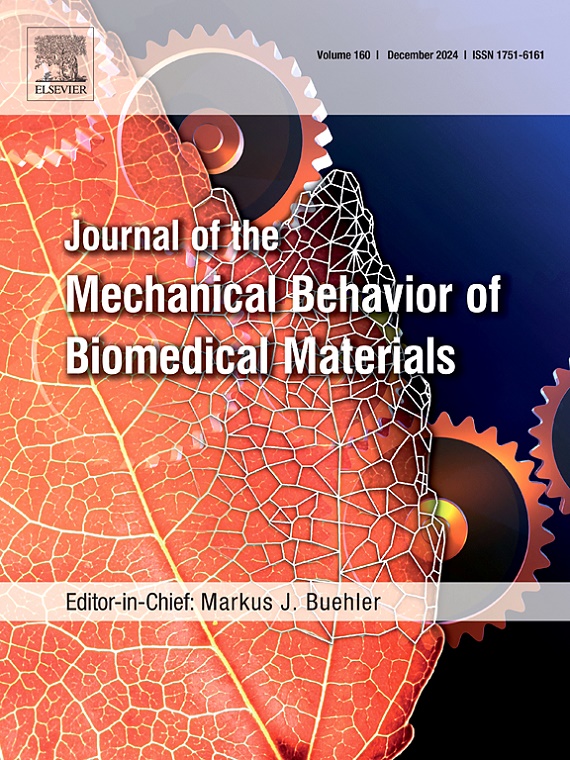利用快速制造的三重周期性最小表面结构提高下颌骨重建板的功能性
IF 3.3
2区 医学
Q2 ENGINEERING, BIOMEDICAL
Journal of the Mechanical Behavior of Biomedical Materials
Pub Date : 2024-11-20
DOI:10.1016/j.jmbbm.2024.106826
引用次数: 0
摘要
用于制造患者专用口腔和颌面部植入物的快速成型制造技术可实现最佳装配,大大缩短手术时间并降低后续成本。然而,硬件或生物相关的并发症仍然很常见,特别是在涉及放射治疗时。就下颌骨重建板而言,由于受辐射组织的血管减少,受辐射患者经常会出现重建板松动和随后的重建板暴露。我们假设,在放射治疗前加速骨的生长可以提高骨板的存活率。在这项工作中,我们提出了一种新的下颌骨重建钢板设计方案,以促进骨结合,同时在愈合过程中提供必要的机械支撑。为此,我们使用激光粉末熔床制造了六种不同的三周期最小表面(TPMS)结构。对其进行了三点弯曲和体外细胞活力测试。机械测试表明,所有结构都能安全地承受记录的咬合力,Gyroid 结构的弯曲模量较低,因此适用性较好。最后,细胞活力测试证实,所有 TPMS 结构的细胞增殖率都很高,细胞与表面的粘附性也很好。总之,新的设计理念显示出作为一种可行的板材选择的潜力,它具有更好的功能和更高的存活率。本文章由计算机程序翻译,如有差异,请以英文原文为准。

Towards improved functionality of mandibular reconstruction plates enabled by additively manufactured triply periodic minimal surface structures
Additive manufacturing for fabrication of patient-specific oral and maxillofacial implants enables optimal fitting, significantly reducing surgery time and subsequent costs. However, it is still common to encounter hardware- or biological-related complications, specifically when radiation treatment is involved. For mandibular reconstruction plates, irradiated patients often experience plate loosening and subsequent plate exposure due to a decrease in the vascularity of the irradiated tissues. We hypothesize that an acceleration of the bone ingrowth prior to radiation treatment can increase the survival of such plates. In this work, a new design of a mandibular reconstruction plate is proposed to promote osseointegration, while providing the necessary mechanical support during healing. In this regard, six different Triply Periodic Minimal Surface (TPMS) structures were manufactured using laser-powder bed fusion. Three-point bending and in-vitro cell viability tests were performed. Mechanical testing demonstrated the ability for all structures to safely withstand documented biting forces, with favorable applicability for the Gyroid structure due its lower flexural modulus. Finally, cell viability tests confirmed high cell proliferation rate and good cell adhesion to the surface for all TPMS structures. Overall, the new design concept shows potential as a viable option for plates with improved functionality and higher survival rate.
求助全文
通过发布文献求助,成功后即可免费获取论文全文。
去求助
来源期刊

Journal of the Mechanical Behavior of Biomedical Materials
工程技术-材料科学:生物材料
CiteScore
7.20
自引率
7.70%
发文量
505
审稿时长
46 days
期刊介绍:
The Journal of the Mechanical Behavior of Biomedical Materials is concerned with the mechanical deformation, damage and failure under applied forces, of biological material (at the tissue, cellular and molecular levels) and of biomaterials, i.e. those materials which are designed to mimic or replace biological materials.
The primary focus of the journal is the synthesis of materials science, biology, and medical and dental science. Reports of fundamental scientific investigations are welcome, as are articles concerned with the practical application of materials in medical devices. Both experimental and theoretical work is of interest; theoretical papers will normally include comparison of predictions with experimental data, though we recognize that this may not always be appropriate. The journal also publishes technical notes concerned with emerging experimental or theoretical techniques, letters to the editor and, by invitation, review articles and papers describing existing techniques for the benefit of an interdisciplinary readership.
 求助内容:
求助内容: 应助结果提醒方式:
应助结果提醒方式:


